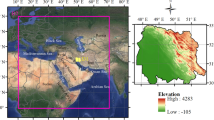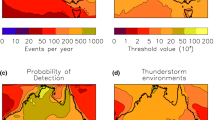Abstract
The factors controlling lightning activity over central Israel and the adjacent Mediterranean Sea were studied. Potential predictors were correlated at 12-h intervals with total number of flashes. Since during the winter season lightning is generated in this region by Cyprus Lows, the data includes 283 observations on days in which this system prevailed for December to February, which covered four winters. The average lightning rate was 26.8 h-1, with a high standard deviation of 55.2 h-1. The total number of flashes at night exceeded the daytime number by 35%, in agreement with previous studies. The CAPE values were on the order of hundreds of J kg-1. A statistical linear multi-regression model was developed for the number of lightning flashes based on 35 atmospheric variables. The correlation between the modeled and the observed number of lightning flashes was 0.67, and 0.81 for the logarithm of the number of lightning flashes (log-lightning). This suggests that the lightning intensity responds exponentially to its governing factors. A linear multi-regression stepwise model for the log-lightning selected seven predictors as significant and yielded a correlation of 0.74. This model was validated by three holdout and three leave-one-out validation experiments. The composition and hierarchy of the significant predictors reflect the dominance of the thermodynamic factors, in particular instability, in determining lightning activity. Though thunderstorms are local or meso-scale phenomena, the synoptic-scale atmospheric variables were found to be powerful predictors for their intensity.




Similar content being viewed by others
References
Alpert P, Reisin T (1986) An early winter polar airmass penetration to the eastern Mediterranean. Mon Wea Rev 114:1411–1418
Alpert P, Shafir C (1989) Meso-γ-scale distribution of orographic precipitation: numerical study and comparison with precipitation derived from radar measurements. J App Meteor 28:1105–1117
Alpert P, Neeman BU, Shay-El Y (1990) Climatological analysis of Mediterranean cyclones using ECMWF data. Tellus 42A:65–77
Altaratz O, Levin Z, Yair Y, Ziv B (2003) Lightning activity over land and sea on the eastern coast of the Mediterranean. Mon Wea Rev 131:2060–2070
Cherna EV, Stansbury EJ (1986) Sferics rate in relation to thunderstorm dimensions. J Geophys Res 91: D8 DOI 10.1029/0JGREA0000910000D8008701000001
Dayan U, Ziv B, Margalit A, Morin E, Sharon D (2001) A severe autumn storm over the Middle-East: Synoptic and mesoscale convection analysis. Theor Appl Climatol 69:103–122
Goldreich Y (2003) The climate of Israel: observation, research and application. Kluwer,Dordrecht, p 270
HMSO (1962) Weather in the Mediterranean I: general meteorology, 2nd edn. Her Majesty’s Stationery Office, London, p 362
Holton JR (1992) An Introduction to dynamic meteorology, 2nd edn. Academic Press, New York, p 507
Kahana R, Ziv B, Enzel Y, Dayan U (2002) Synoptic climatology of major floods in the Negev Desert, Israel. Int J Climatol 22:867–882
Kalnay E, Kanamitsu M, Kistler R, Collins W, Deaven D, Gandin L, Iredell M, Saha S, White G, Woollen J, Zhu Y, Chelliah M, Ebisuzaki W, Higgins W, Janowiak J, Mo KC, Ropelewski C, Wang J, Leetmaa A, Reynolds R, Jenne R, Joseph D (1996) The NCEP/NCAR 40-year reanalysis project. Bull Am Meteor Soc 77:437–471
Kistler R, Kalnay E, Collins W, Saha S, White G, Woollen J, Chelliah M, Ebisuzaki W, Kanamitsu M, Kousky V, Van Den Dool H, Jenne R, Fiorino M (2001) The NCEP-NCAR 50-year reanalysis: monthly means CD-ROM and documentation. Bull Am Meteor Soc 82:247–267
Kitigawa N, Michimoto K (1994) Meteorological and electrical aspects of winter thunderclouds. J Geophys Res 99:10713–10721
Levin Z, Yair Y, Ziv B (1996) Positive cloud-to-ground flashes and wind shear in Tel-Aviv thunderstorms. Geophys Res Lett 23:2231–2234
MacGorman DM, Rust WD (1998) The electrical nature of storms. Oxford University Press, Oxford, p 422
Mackerras D (1985) Automatic short-range measurements of the cloud flash to ground flash ratio in thunderstorms. J Geophys Res 90:6195–6201
Nautra A (1982) Lightning storm damage in Israel. Meteorologia BeIsrael 3–4/82:33–38 (in Hebrew)
Piepgrass MV, Krider EP, Moore CB (1982) Lightning and surface rainfall during Florida thunderstorms. J Geophys Res 87:11193–11201
Price C, Federmesser B (2006) Lightning-rainfall relationships in Mediterranean winter thunderstorms. Geophys Res Lett 33: L07813, DOI 10.1029/2005GL024794
Rosenfeld D, Farbstein H (1992) Possible influence of desert dust on seedability of clouds in Israel. J Appl Meteor 31:722–731
Rosenfeld D, Gagin A (1989) Factors governing the total rainfall from continental convective clouds. J Appl Meteor 28:1015–1030
Rutledge SA, Williams ER, Kennan TD (1992) The down under Doppler and electricity experiment (DUNDEE): overview and preliminary results. Bull Am Meteor Soc 73:3–16
Shay-El Y, Alpert P (1991) A diagnostic study of winter diabatic heating in the Mediterranean in relation to cyclones. Q J Roy Meteor Soc 117:715–747
Siedlecki M (2006) The diurnal course of the CAPE index values. 6th Annual Meeting of the European Meteorological Society and the 6th European Conference on Applied Climatology, Ljubljana, Slovenia (EMS2006-A-00590)
Stolzenburg M (1994) Observations of high ground flash densities of positive lightning in summertime thunderstorms. Mon Wea Rev 122:1740–1750
Tapia A, Smith JA, Dixon M (1998) Estimation of convective rainfall from lightning observations. J Appl Meteor 37:1497–1508
Thompson RL, Edwards R, Hart JA, Elmore KL, Markowski P (2003) Close proximity soundings within supercell environments obtained from the Rapid Update Cycle. Wea Forecasting 18:1243–1261
Van Den Broeke MS, Schultz DM, Johns RH, Evans JS, Hales JE (2005) Cloud-to-ground lightning production in strongly forced, low-instability convective lines associated with damaging wind. Wea Forecasting 20:517–530
Williams ER, Webber ME, Orville RE (1989) The relationship between lightning type and convective state of thunderclouds. J Geophys Res 94:213–220
Yair Y, Levin Z, Altaratz O (1998) Lightning phenomenology in the Tel-Aviv area from 1989 to 1996. J Geophys Res 103:9015–9025
Zangvil A, Druyan P (1990) Upper air trough axis orientation and the spatial distribution of rainfall over Israel. Int J Climatol 10:57–62
Acknowledgements
This study was supported by the Israeli Science Foundation (ISF, grants 145/03 and 764/06).
Author information
Authors and Affiliations
Corresponding author
Rights and permissions
About this article
Cite this article
Ziv, B., Saaroni, H., Yair, Y. et al. Atmospheric factors governing winter thunderstorms in the coastal region of the eastern Mediterranean. Theor Appl Climatol 95, 301–310 (2009). https://doi.org/10.1007/s00704-008-0008-6
Received:
Accepted:
Published:
Issue Date:
DOI: https://doi.org/10.1007/s00704-008-0008-6




